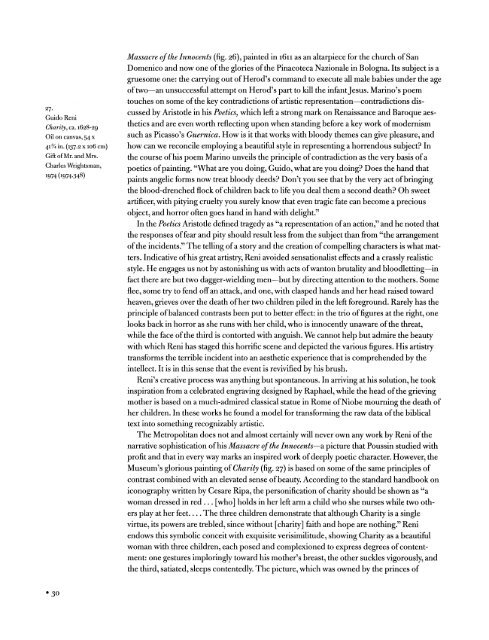GOING FOR BAROQUE Into the Bin - The Metropolitan Museum of Art
GOING FOR BAROQUE Into the Bin - The Metropolitan Museum of Art
GOING FOR BAROQUE Into the Bin - The Metropolitan Museum of Art
Create successful ePaper yourself
Turn your PDF publications into a flip-book with our unique Google optimized e-Paper software.
Massacre <strong>of</strong> <strong>the</strong> Innocents (fig. 26), painted<br />
in 1611 as an altarpiece<br />
for <strong>the</strong> church <strong>of</strong> San<br />
Domenico and now one <strong>of</strong> <strong>the</strong> glories<br />
<strong>of</strong> <strong>the</strong> Pinacoteca Nazionale in Bologna.<br />
Its subject<br />
is a<br />
27<br />
Guido<br />
Charity,<br />
Reni<br />
ca. 1628-29<br />
Oil on canvas, 54 x<br />
4i3/4 in. (137.2<br />
x 106 cm)<br />
Gift <strong>of</strong> Mr. and Mrs.<br />
Charles<br />
Wrightsman,<br />
1974 (1974.348)<br />
gruesome<br />
one: <strong>the</strong> carrying<br />
out <strong>of</strong> Herod's command to execute all male babies under <strong>the</strong> age<br />
<strong>of</strong> two?an unsuccessful attempt<br />
on Herod's part<br />
to kill <strong>the</strong> infant Jesus. Marino's poem<br />
touches on some <strong>of</strong> <strong>the</strong> key<br />
contradictions <strong>of</strong> artistic<br />
representation?contradictions<br />
dis<br />
cussed<br />
by Aristotle in his Poetics, which left a strong mark on Renaissance and aes<br />
Baroque<br />
<strong>the</strong>tics and are even worth<br />
reflecting upon when<br />
standing<br />
before a key<br />
work <strong>of</strong> modernism<br />
such as Picasso's Guernica. How is it that works with<br />
bloody<br />
<strong>the</strong>mes can give pleasure,<br />
and<br />
how can we reconcile<br />
a<br />
employing<br />
beautiful<br />
style<br />
in a representing<br />
horrendous<br />
subject?<br />
In<br />
<strong>the</strong> course <strong>of</strong> his poem Marino unveils <strong>the</strong> principle<br />
<strong>of</strong> contradiction as <strong>the</strong> very basis <strong>of</strong> a<br />
poetics<br />
<strong>of</strong> painting.<br />
"What are you doing, Guido, what are you doing?<br />
Does <strong>the</strong> hand that<br />
paints angelic<br />
forms now treat bloody<br />
deeds? Don't you<br />
see that by<br />
<strong>the</strong> very act <strong>of</strong> bringing<br />
<strong>the</strong> blood-drenched flock <strong>of</strong> children back to life you deal <strong>the</strong>m a second death? Oh sweet<br />
artificer, with pitying cruelty you surely know that even tragic fate can become a precious<br />
object,<br />
and horror <strong>of</strong>ten goes hand in hand with<br />
delight."<br />
In <strong>the</strong> Poetics Aristotle defined<br />
as<br />
tragedy<br />
"a representation <strong>of</strong> an action," and he noted that<br />
<strong>the</strong> responses <strong>of</strong> fear and pity<br />
should result less from <strong>the</strong> subject than from "<strong>the</strong> arrangement<br />
<strong>of</strong> <strong>the</strong> incidents." <strong>The</strong><br />
telling<br />
<strong>of</strong> a story and <strong>the</strong> creation <strong>of</strong> compelling<br />
characters is what mat<br />
ters. Indicative <strong>of</strong> his great artistry,<br />
Reni avoided sensationalist effects and a crassly<br />
realistic<br />
style. He engages<br />
us not us by astonishing<br />
with acts <strong>of</strong> wanton<br />
brutality<br />
and bloodletting?in<br />
fact <strong>the</strong>re are but two dagger-wielding<br />
men?but<br />
by directing<br />
attention to <strong>the</strong> mo<strong>the</strong>rs. Some<br />
flee,<br />
some<br />
try to fend <strong>of</strong>f an attack, and one, with clasped hands and her head raised toward<br />
heaven,<br />
over<br />
grieves<br />
<strong>the</strong> death <strong>of</strong> her two children<br />
piled<br />
in <strong>the</strong> left foreground. Rarely<br />
has <strong>the</strong><br />
principle<br />
<strong>of</strong> balanced contrasts been put<br />
to better effect: in <strong>the</strong> trio <strong>of</strong> figures<br />
at <strong>the</strong> one right,<br />
looks back in horror as she runs with her child, who is unaware<br />
innocently<br />
<strong>of</strong> <strong>the</strong> threat,<br />
while <strong>the</strong> face <strong>of</strong> <strong>the</strong> third is contorted with<br />
anguish. We cannot help<br />
but admire <strong>the</strong> beauty<br />
with which Reni has<br />
staged<br />
this horrific scene and depicted <strong>the</strong> various<br />
figures.<br />
His<br />
artistry<br />
transforms <strong>the</strong> terrible incident into an aes<strong>the</strong>tic<br />
experience that is comprehended by<br />
<strong>the</strong><br />
intellect. It is in this sense that <strong>the</strong> event is revivified<br />
by<br />
his brush.<br />
Reni's creative process<br />
was<br />
anything<br />
but spontaneous. In arriving<br />
at his solution, he took<br />
inspiration from a celebrated<br />
engraving designed by Raphael, while <strong>the</strong> head <strong>of</strong> <strong>the</strong> grieving<br />
mo<strong>the</strong>r is based on a much-admired classical statue in Rome <strong>of</strong> Niobe<br />
mourning<br />
<strong>the</strong> death <strong>of</strong><br />
her children. In <strong>the</strong>se works he found a model for transforming<br />
<strong>the</strong> raw data <strong>of</strong> <strong>the</strong> biblical<br />
text into something recognizably<br />
artistic.<br />
<strong>The</strong><br />
<strong>Metropolitan</strong><br />
does not and almost<br />
certainly<br />
will never own<br />
any work by<br />
Reni <strong>of</strong> <strong>the</strong><br />
narrative<br />
sophistication<br />
<strong>of</strong> his Massacre<br />
<strong>of</strong><br />
<strong>the</strong> Innocents?a<br />
picture<br />
that Poussin studied with<br />
pr<strong>of</strong>it<br />
and that in every way marks an inspired work <strong>of</strong> deeply poetic<br />
character. However, <strong>the</strong><br />
<strong>Museum</strong>'s<br />
glorious painting<br />
o? Charity (fig. 27)<br />
is based on some <strong>of</strong> <strong>the</strong> same principles<br />
<strong>of</strong><br />
contrast combined with an elevated sense <strong>of</strong> beauty.<br />
to According<br />
<strong>the</strong> standard handbook on<br />
iconography<br />
written<br />
by Cesare Ripa,<br />
<strong>the</strong> personification <strong>of</strong> charity<br />
should be shown as "a<br />
woman dressed in red ...<br />
[who]<br />
holds in her left arm a child who she nurses while two oth<br />
ers play<br />
at her feet_<strong>The</strong> three children demonstrate that although Charity<br />
is a single<br />
virtue, its powers<br />
are trebled, since without<br />
[charity]<br />
faith and are hope nothing."<br />
Reni<br />
endows this symbolic<br />
conceit with<br />
exquisite verisimilitude, as a<br />
showing Charity<br />
beautiful<br />
woman with three children, each posed<br />
and complexioned<br />
to express degrees<br />
<strong>of</strong> content<br />
ment: one<br />
gestures imploringly<br />
toward his mo<strong>the</strong>r's breast, <strong>the</strong> o<strong>the</strong>r suckles<br />
vigorously,<br />
and<br />
<strong>the</strong> third, satiated, sleeps contentedly.<br />
<strong>The</strong><br />
picture,<br />
which was owned<br />
by<br />
<strong>the</strong> princes<br />
<strong>of</strong><br />
30
















